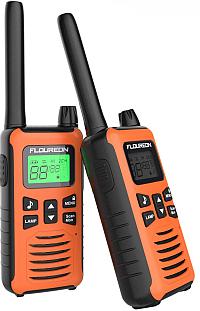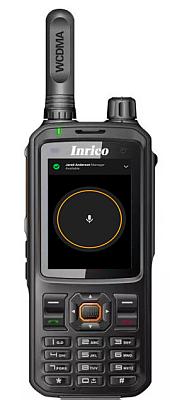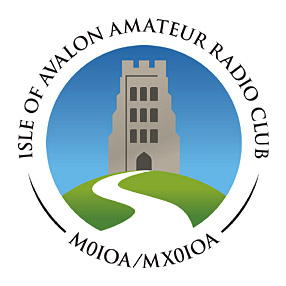What are CB and PMR466? - Licence-free radio
An Amateur Radio licence is not essential to use civilian radio communications in the UK - there are two frequency ranges that do not require licensing in the UK and are good solutions for short-range communications of up to a mile to a few miles depending on terrain and antenna locations. Licensed radio - either Amateur or Business will give you better performance in terms of range, protection from interference and availability, but these solutions may meet your requirements and are worth knowing about.
The mobile phone is an excellent solution to one to one communications, but radio still has a place, either outside phone coverage or where several people hearing a shared communication channel is a better fit to the requirements. This is a high-level guide to the two licence-free solutions in the UK as well as a mobile data-based version called Network Radios, and what conditions you might favour one over the other. To use licence-free radio legally in the UK you need to use unmodified type-approved equipment.
PMR446 is generally more suited to handheld use while CB, slightly more powerful, is suited to vehicle-mounted or base-to-vehicle communication.
PMR446

Equipment is small, handheld portable, and cheap. It’s a great solution for family groups wanting to keep in touch with each other in the great outdoors, in Europe we call this PMR446, but in the States the very similar though incompatible system goes by the more descriptive name Family Radio Service. It’s very good for use around campsites and outdoor activity groups like Scout groups and people on a building site. Perfect for between the house and a garden shed, even if you have a very large garden.
It is also good for small businesses to use casually on a modest site of up to a few acres, and is often used by businesses. Unlike amateur radio there is no prohibition on commercial use. If radio comms is mission critical, however, you may be better off with licensed business radio, particularly in urban areas. Licensing means you have frequencies allocated to you which improves availability of comms.
PMR446 has only 16 frequencies, but also uses CTCSS to divide each of these frequencies up into about 30 user groups. Users set to one CTCSS code don’t hear transmissions from other users, but only one signal can use a frequency at a time - you may block a conversation you can’t hear, or be blocked by other users who can’t hear you. This isn’t usually a practical problem dues to the short (one or two miles) range but can be a problem in large public groups like festivals.
PMR446 is exclusively handheld to handheld nowadays, and the type approval requires a fixed non-removable antenna, so you are limited if you want to use a radio inside a building with an outside aerial - you can’t.
Ofcom prohibit base station usage:
Both Analogue and Digital PMR446 equipment must be used on a mobile basis only for it to meet the licence-exempt operation requirements within the UK. Please note that PMR446 equipment that is designed for base station use, or mobile equipment that is configured as a base station,e.g. as an Internet Gateway, is unlikely to meet the licence-exempt operation requirements.
In amateur radio terms PMR446 is near the 70cm band, but power output is limited to 0.5W e.r.p.
Ignore advertising puffery that describes PMR446 as ‘long range’. G7LEE and G5FM tested a pair of the Floureon PMR446 rigs shown. A range of a mile in a light urban environment was usable, but not much more. Stand on a hilltop and talk to someone else on a hilltop and you can do much better. If you have such a situation PMR446 gear is cheap enough to try it, but a mile is as far as you can normally expect in open terrain. An Amateur radio handheld on 2m or 70cm can do a lot better, with more power and the use of better aerials.
CB
Equipment is a bit dearer than PMR446 and usually vehicle-mount form-factor designed for 12V vehicle power supplies. It can easily be used at home powered from a mains power supply.
Good for base to base, base to vehicle and vehicle to vehicle communications, poor for handheld. You can mount external antennas, which makes base usage better. For handheld comms, you are much better off with PMR446. This is due to the physical limitations of the 10 meter wavelength compared to PMR446’s 70cm wavelength. Aerials less than 1/4 wavelength become inefficient, not many handheld users want to tote something with a 2.5m antenna. You can buy CB handhelds, but just because something exists doesn’t mean it works well.
CB is limited to only 4W of power on FM, though EU harmonisation means more power is available on SSB1. The frequency around 27MHz means antennas are long, more suited to vehicles than handheld. It is useful for professional drivers and to farmers, but by design only rarely achieves anything which can be called long distance or ‘DX’. It has a following among truckers and the 4x4 off-road community, and works well on farms.
Typical ranges are 2 to 4 miles. If you elevate the antennas and use sideband you can double that. The flexibility of mounting the aerial away from the rig meant that taxicab firms could cover a small town via CB by putting the base antenna on a mast. The 10m band means that you can get much greater ranges from unpredictable ionospheric reflection, “skip” in CB parlance, particularly when sunspot activity is high. This is a boon to DXers and a curse to local users when high-powered Italian stations come storming in, making it hard to hear your local contact.
Network Radios

Network radios mimic the shared talk channel of radio communications, but work via wi-fi of mobile telephone data networks, sometimes switching between both. Some are based on Android smartphones, but a network radio doesn’t necessarily work as a mobile phone. There are also hybrid devices with network radio and a RF radio. A free way to trial network radios is with the Zello app on a smartphone - choose Zello personal to try it out. You join user groups which then appears as a shared channel much like a repeater. Zello is a little bit clunky on a smartphone but lets you tip a toe in the water for free, specific hardware can make the user experience much more slick and very much like the radio experience, with the benefits of much higher sound quality and a worldwide reach. Prices are higher than for the analogue solutions, more in the range of mid-level smartphone prices than bargain basement.
Network radios have a lot of potential for business use, but there are channels set up for general usage and for specific interest groups. See Essex Ham’s Network Radios article for more detail. This is available in handheld form factors and vehicle mobile forms, though note the requirement for a mobile data signal. Vehicle rigs will do fine on the motorway network and in urban areas, not so much 4x4 off-roading.

Network radios need a mobile signal, or reliable wi-fi coverage of the operating area. If you haven’t got that, it’s a showstopper. Amateur radio, PMR446, CB, and business digital mobile radio are independent of the Internet and mobile networks.
Conclusion
These are your main options for license-free voice radio comms. There are more options for data links - WiFi on the ISM bands of 2400-2500 MHz and 5470-5850MHz, SRD devices around 433 and 864 MHz but this is too specialised for this page.
-
12W on SSB see Ofcom IR2027.2 ↩
